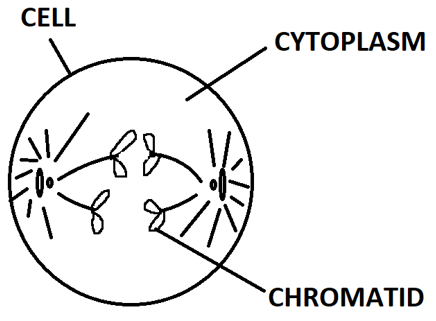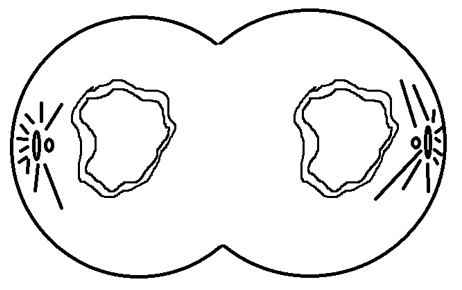This set of Class 11 Biology Chapter 10 Multiple Choice Questions & Answers (MCQs) focuses on “Cell Cycle and Cell Division” for NEET Preparation.
1. Which of these events do not take place during metaphase?
a) Chromosomes lie at the equator of the cell
b) One chromatid of each chromosome is attached to the spindle fiber
c) Chromosomes spread throughout the cytoplasm
d) Nuclear envelope starts to disintegrate
View Answer
Explanation: During metaphase, the nuclear envelope has completely disintegrated. The chromosomes spread out throughout the cytosol and the chromosomes lie at the equatorial plane, attached to spindle fibers.
2. Which phase is marked by the separation of sister chromatids?
a) Prophase
b) Metaphase
c) Anaphase
d) Telophase
View Answer
Explanation: Anaphase is the third stage of M phase or mitosis. It succeeds metaphase, the phase during which the chromosomes align themselves along the equator of the cell. In anaphase, they start separating towards the poles.
3. In which direction does each chromatid move on separation of sister chromatids?
a) Towards the nuclear envelope
b) Towards the equatorial plane
c) Towards the poles
d) Towards adjacent chromatids
View Answer
Explanation: Separation of the sister chromatids occurs during the third stage of mitosis or the M phase of the cell cycle, known as anaphase. The chromatids separate from each other and move to the opposite poles of the cell.
4. In which direction are the centromeres directed during separation of chromosomes?
a) Towards the poles
b) Towards the equatorial plane
c) Towards adjacent chromatids
d) Towards the nuclear envelope
View Answer
Explanation: Separation of the sister chromatids occurs during the third stage of mitosis, known as anaphase. The centromeres of each chromatid are directed towards the poles while the arms of the chromosomes trail behind them.
5. Identify the stage of mitosis.

a) Telophase
b) Anaphase
c) Prophase
d) Metaphase
View Answer
Explanation: In the given diagram, the sister chromatids have separated from each other at the centromeres and are moving towards the opposite poles of the cell. Thus, the stage is identified to be anaphase.
6. What is the final stage of karyokinesis?
a) Prophase
b) G2 phase
c) Telophase
d) G1 phase
View Answer
Explanation: Karyokinesis is the division of the nucleus. This proceeds after the genetic material has been replicated and the sister chromatids have undergone separation. Thus, the final stage of karyokinesis is telophase, which is the last stage of mitosis.
7. Which of these events does not take place during telophase?
a) Chromosomes are distinct and clear
b) Chromosomes are present at the poles
c) Chromosomes are decondensed
d) Chromosomes lose their individuality
View Answer
Explanation: Telophase is the last stage of mitosis or the M phase of cell cycle. During telophase, the chromosomes are present at the poles. They lose their individuality and are decondensed. They cannot be clearly visualized.
8. During which stage of the cell cycle does the nuclear envelope reform?
a) G1 phase
b) Cytokinesis
c) Anaphase
d) Telophase
View Answer
Explanation: The nuclear envelope reforms after the division of the sister chromatids and their migration to the opposite poles of the cell. Hence, it reforms during the last stage of mitosis, telophase.
9. During which stage of cell cycle do the major organelles reform?
a) Prophase
b) Anaphase
c) Telophase
d) G2 phase
View Answer
Explanation: The major organelles of the cell, such as the nucleolus, the Golgi apparatus and the endoplasmic reticulum, are reformed after the sister chromatids have separated and migrated to the opposite poles, during telophase.
10. Chromosomes lose their individuality in anaphase. True or false?
a) True
b) False
View Answer
Explanation: Chromosomes decondense and lose their individuality during telophase of the M phase or mitosis phase of the cell cycle. It is the last stage of mitosis and is followed by cell division or cytokinesis.
11. Identify the stage of cell division.

a) Prophase
b) Metaphase
c) Anaphase
d) Telophase
View Answer
Explanation: The diagram shows the presence of nuclear envelope near the opposite poles of the dividing cells. This signifies that prophase, metaphase and anaphase have already taken place. Thus, telophase is depicted.
12. Why do plants not undergo furrowing during cytokinesis?
a) Absence of centrioles
b) Presence of rigid vascular bundle
c) Presence of cell wall
d) Presence of large vacuoles
View Answer
Explanation: Animal cells undergo furrowing during cell division or cytokinesis. The furrow deepens, ultimately forming two cells. The presence of a relatively inextensible cell wall prevents furrowing in plant cells.
13. From where does wall formation start between two newly formed plant cells?
a) Cell wall
b) Cell membrane
c) Centre of the cell
d) Cytoplasm
View Answer
Explanation: The presence of a relatively inextensible cell wall prevents furrowing in plant cells. The plant cells instead undergo separation by cell plate formation that starts from the center of the plant cell.
14. The cell-plate of plant cells represents the ______
a) middle lamella
b) primary cell wall
c) secondary cell wall
d) plasmodesmata
View Answer
Explanation: Plant cells undergo separation by cell-plate formation that starts from the center of the plant cell. It does not undergo furrowing like animal cells. The cell-plate represents the middle lamella.
15. Which of these is an example of syncytium in coconut?
a) Fleshy endosperm
b) Liquid endosperm
c) Endocarp
d) Mesocarp
View Answer
Explanation: Syncytium is a cytoplasmic mass of cells that are multinucleated. This multinucleate condition arises due to absence of cytokinesis or cell division following karyokinesis or nuclear division.
Sanfoundry Global Education & Learning Series – Biology – Class 11.
To practice all chapters and topics of class 11 Biology for NEET, here is complete set of 1000+ Multiple Choice Questions and Answers.
If you find a mistake in question / option / answer, kindly take a screenshot and email to [email protected]
- Practice Class 12 - Biology MCQs
- Practice Class 11 - Mathematics MCQs
- Practice Class 11 - Chemistry MCQs
- Check Class 11 - Books
- Practice Class 11 - Physics MCQs
